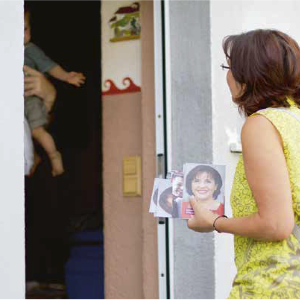The Interpreter: Jörg Haßler on ‘microtargeting’
30 Dec 2021
LMU researchers explain technical terms for general readers
30 Dec 2021
LMU researchers explain technical terms for general readers

Party advertising during election campaigns. | © Daniel Reinhardt / Picture Alliance / dpa
Some scientific terms have made it into everyday discourse. Here, LMU researchers tell us what these expressions mean – and not just with a definition, but with a brief history of their usage.
Jörg Haßler: “Microtargeting is a technique that comes from direct marketing, which involves addressing target groups individually. It was made possible by the use of data, which we provide to marketers through social media – particularly Facebook, the platform with the biggest range. For some years, microtargeting has also been used in the political sphere. In the United States, Barack Obama perfected the technique, and Donald Trump also employed it to good effect. The parties and campaign teams there possess their own databases, in particular detailed voter registers. These databases contain personal information right down to voting decisions, and they are combined with the data available through Facebook. The result is individual election ads.
Donald Trump’s campaign in particular deliberately employed false statements and exploited prejudices. Election ads containing these elements were often spread online without critical commentary. In Europe, there are stricter data protection regulations for political campaigning. It’s not been so easy over here to collate data from different sources at the personal level. That being said, it’s still possible via the filter tools in Facebook to address certain groups in a targeted manner – say, young people who are interested in electric cars.
Over the past few years, the willingness of politics to use new tools has sharply increased. The parties are trying out a lot of different tacks and it cannot be ruled out that they could be straying into gray areas.Dr. Jörg Haßler
For some time now, parties in Germany have been trying to build up their own databases and collect information about their voters, while canvassing door to door or online. For example, the CDU party runs the “CDU-connect” platform. If it creates the profile of a typical party voter based on the information it collects there, it can search for statistical twins through Facebook – that is to say, people with similar characteristics as the voters – and then offer the twins targeted election ads via social media. Over the past few years, the willingness of politics to use new tools has sharply increased. The parties are trying out a lot of different tacks and it cannot be ruled out that they could be straying into gray areas.
I find the democratic theory component of this important. If political actors put out different or even contradictory statements to different sections of the public, the voters may no longer know in extreme cases what positions a party stands for. An example could be that a party sends out pro-climate messages to young people whom they know have read up on climate neutrality, while at the same time sending out to independents deregulatory messages advocating policies that would tend to harm the environment. We’re actually witnessing such trends.
We need clear guidelines for transparency.Dr. Jörg Haßler
For this reason, there has been a library in Germany for Facebook since 2019 in which election ads are deposited. This came about only as a result of public pressure. However, it is not complete. Moreover, it is not apparent how much money parties have spent on ads and campaigns. There is a huge need for regulation here in Germany and the EU. We need clear guidelines for transparency.”
Protokoll: huf

Jörg Haßler | © privat
Dr. Jörg Haßler heads the Digital Democratic Mobilization in Hybrid Media Systems (DigiDeMo) junior research group at the Department of Media and Communication (IfKW) at LMU.